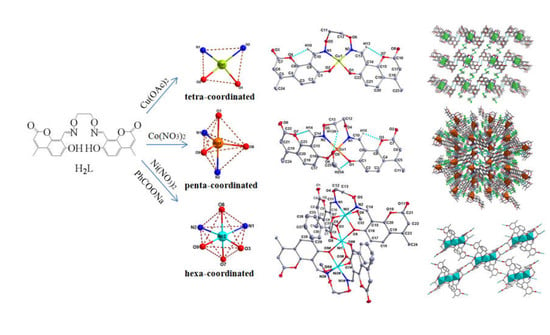Tetra-, Penta- and Hexa-Coordinated Transition Metal Complexes Constructed from Coumarin-Containing N2O2 Ligand
Abstract
:1. Introduction
2. Experimental
2.1. Materials and Methods
2.2. Synthesis of H2L
2.3. Synthesis of Complex 1
2.4. Synthesis of Complex 2
2.5. Synthesis of Complex 3
2.6. X-ray Crystal Structure Determinations for Complexes 1, 2 and 3
3. Results and Discussion
3.1. IR Spectra
3.2. UV-VIS Spectra
3.3. Fluorescence Properties
3.4. Crystal Structure Description of Complex 1
3.5. Crystal Structure Description of Complex 2
3.6. Crystal Structure Description of Complex 3
3.7. Antimicobial Activities
4. Conclusions
Acknowledgments
Author Contributions
Conflicts of Interest
References
- Zhao, L.; Dang, X.T.; Chen, Q.; Zhao, J.X.; Wang, L. Synthesis, crystal structure and spectral properties of a 2D supramolecular copper(II) complex with 1-(4-{[(E)-3-ethoxyl-2-hydroxybenzylidene]amino}phenyl)ethanone oxime. Synth. React. Inorg. Met.-Org. Nano-Met. Chem. 2013, 43, 1241–1246. [Google Scholar] [CrossRef]
- Wu, H.L.; Pan, G.L.; Bai, Y.C.; Wang, H.; Kong, J.; Shi, F.; Zhang, Y.H.; Wang, X.L. Preparation, structure, DNA-binding properties, and antioxidant activities of a homodinuclear erbium(III) complex with a pentadentate Schiff base ligand. J. Chem. Res. 2014, 38, 211–217. [Google Scholar] [CrossRef]
- Sun, Y.X.; Zhang, S.T.; Ren, Z.L.; Dong, X.Y.; Wang, L. Synthesis, characterization, and crystal structure of a new supramolecular CdII complex with halogen-substituted salen-type bisoxime. Synth. React. Inorg. Met.-Org. Nano-Met. Chem. 2013, 43, 995–1000. [Google Scholar] [CrossRef]
- Song, X.Q.; Liu, P.P.; Liu, Y.A.; Zhou, J.J.; Wang, X.L. Two dodecanuclear heterometallic [Zn6Ln6] clusters constructed by a multidentate salicylamide salen-like ligand: Synthesis, structure, luminescence and magnetic properties. Dalton Trans. 2016, 45, 8154–8163. [Google Scholar] [CrossRef] [PubMed]
- Xu, L.; Zhu, L.C.; Ma, J.C.; Zhang, Y.; Zhang, J.; Dong, W.K. Syntheses, structures and spectral properties of mononuclear CuII and dimeric ZnII complexes an asymmetric Salamo-type N2O2 ligand. Zeitschrift für Anorganische und Allgemeine Chemie 2015, 641, 2520–2524. [Google Scholar] [CrossRef]
- Wang, P.; Zhao, L. Synthesis and crystal structure of supramolecular copper(II) complex N2O2 coordination Sphere. Asian J. Chem. 2015, 4, 1424–1426. [Google Scholar] [CrossRef]
- Sun, Y.X.; Wang, L.; Dong, X.Y.; Ren, Z.L.; Meng, W.S. Synthesis, characterization, and crystal structure of a supramolecular CoII complex containing Salen-type bisoxime. Synth. React. Inorg. Met-Org. Nano-Met. Chem. 2013, 43, 599–603. [Google Scholar] [CrossRef]
- Wu, H.L.; Bai, Y.C.; Zhang, Y.H.; Pan, G.L.; Kong, J.; Shi, F.; Wang, X.L. Two lanthanide(III) complexes the schiff base N,N-Bis(salicylidene)-1,5-diamino-3-oxapentane: Synthesis, characterization, DNA-binding properties, and antioxidation. Zeitschrift für Anorganische und Allgemeine Chemie 2014, 640, 2062–2071. [Google Scholar] [CrossRef]
- Wu, H.L.; Bai, Y.; Yuan, J.K.; Wang, H.; Pan, G.L.; Fan, X.Y.; Kong, J. A zinc(II) complex with tris(2-(N-methyl)benzimidazlylmethyl)amine and salicylate: Synthesis, crystal structure, and DNA-binding. J. Coord. Chem. 2012, 65, 2839–2851. [Google Scholar] [CrossRef]
- Chen, C.Y.; Zhang, J.W.; Zhang, Y.H.; Yang, Z.H.; Wu, H.L. Gadolinium(III) and dysprosium(III) complexes with a Schiff base bis(N-salicylidene)-3-oxapentane-1,5-diamine: Synthesis, characterization, antioxidation, and DNA-binding studies. J. Coord. Chem. 2015, 68, 1054–1071. [Google Scholar] [CrossRef]
- Wang, F.; Gao, L.; Zhao, Q.; Zhang, Y.; Dong, W.K.; Ding, Y.J. A highly selective fluorescent chemosensor for CN- a novel bis(salamo)-type tetraoxime ligand. Spectrochim. Acta Part A 2018, 190, 111–115. [Google Scholar] [CrossRef] [PubMed]
- Dong, X.Y.; Li, X.Y.; Liu, L.Z.; Zhang, H.; Ding, Y.J.; Dong, W.K. Tri- and hexanuclear heterometallic Ni(II)–M(II) (M = Ca, Sr and Ba) bis(salamo)-type complexes: Synthesis, structure and fluorescence properties. RSC Adv. 2017, 7, 48394–48403. [Google Scholar] [CrossRef]
- Wu, H.L.; Wang, C.P.; Wang, F.; Peng, H.P.; Zhang, H.; Bai, Y.C. A new manganese(III) complex from bis(5-methylsalicylaldehyde)-3-oxapentane-1,5-diamine: Synthesis, characterization, antioxidant activity and luminescence. J. Chin. Chem. Soc. 2015, 62, 1028–1034. [Google Scholar] [CrossRef]
- Dong, W.K.; Ma, J.C.; Zhu, L.C.; Zhang, Y. Self-assembled zinc(II)-lanthanide(III) heteromultinuclear complexes constructed from 3-MeOsalamo ligand: Syntheses, structures and luminescent properties. Cryst. Growth Des. 2016, 16, 6903–6914. [Google Scholar] [CrossRef]
- Song, X.Q.; Peng, Y.J.; Chen, G.Q.; Wang, X.R.; Liu, P.P.; Xu, W.Y. Substituted group-directed assembly of Zn(II) coordination complexes two new structural related pyrazolone Salen ligands: Syntheses, structures and fluorescence properties. Inorg. Chim. Acta 2015, 427, 13–21. [Google Scholar] [CrossRef]
- Dong, W.K.; Zhang, F.; Li, N.; Xu, L.; Zhang, Y.; Zhang, J.; Zhu, L.C. Trinuclear cobalt(II) and zinc(II) salamo–type complexes: Syntheses, crystal structures, and fluorescent properties. Zeitschrift für Anorganische und Allgemeine Chemie 2016, 642, 532–538. [Google Scholar] [CrossRef]
- Song, X.Q.; Cheng, G.Q.; Liu, Y.A. Enhanced Tb(III) luminescence by d10 transition metal coordination. Inorg. Chim. Acta 2016, 450, 386–394. [Google Scholar] [CrossRef]
- Dong, W.K.; Ma, J.C.; Zhu, L.C.; Zhang, Y. Nine self–assembled nickel(II)–lanthanide(III) heterometallic complexes constructed from a Salamo–type bisoxime and bearing N- or O-donor auxiliary ligand: Syntheses, structures and magnetic properties. New J. Chem. 2016, 40, 6998–7010. [Google Scholar] [CrossRef]
- Song, X.Q.; Liu, P.P.; Xiao, Z.R.; Li, X.; Liu, Y.A. Four polynuclear complexes a versatile salicylamide salen-like ligand: Synthesis, structural variations and magnetic properties. Inorg. Chim. Acta 2015, 438, 232–244. [Google Scholar] [CrossRef]
- Dong, W.K.; Ma, J.C.; Dong, Y.J.; Zhu, L.C.; Zhang, Y. Di-and tetranuclear heterometallic 3d-4f cobalt(II)-lanthanide(III) complexes derived from a hexadentate bisoxime: Syntheses, structures and magnetic properties. Polyhedron 2016, 115, 228–235. [Google Scholar] [CrossRef]
- Liu, P.P.; Wang, C.Y.; Zhang, M.; Song, X.Q. Pentanuclear sandwich-type ZnII-LnIII clusters a new Salen-like salicylamide ligand: Structure, near-infrared emission and magnetic properties. Polyhedron 2017, 129, 133–140. [Google Scholar] [CrossRef]
- Wu, H.L.; Pan, G.L.; Wang, H.; Wang, X.L.; Bai, Y.C.; Zhang, Y.H. Study on synthesis, crystal structure, antioxidant and DNA-binding of mono-, di- and poly-nuclear lanthanides complexes with bis(N-salicylidene)-3-oxapentane-1,5-diamine. J. Photochem. Photobiol. B Biol. 2014, 135, 33–43. [Google Scholar] [CrossRef] [PubMed]
- Dong, W.K.; Zhang, J.; Zhang, Y.; Li, N. Novel multinuclear transition metal(II) complexes an asymmetric Salamo-type ligand: Syntheses, structure characterizations and fluorescent properties. Inorg. Chim. Acta 2016, 444, 95–102. [Google Scholar] [CrossRef]
- Dong, Y.J.; Li, X.L.; Zhang, Y.; Dong, W.K. A highly selective visual and fluorescent sensor for Pb2+ and Zn2+ and crystal structure of Cu2+ complex-on a novel single-armed Salamo-type bisoxime. Supramol. Chem. 2017, 29, 518–527. [Google Scholar] [CrossRef]
- Sun, Y.X.; Xu, L.; Zhao, T.H.; Liu, S.H.; Liu, G.H.; Dong, X.T. Synthesis and crystal structure of a 3D supramolecular copper(II) complex with 1-(3-{[(E)-3-bromo-5-chloro-2-hydroxybenzylidene]amino}phenyl) ethanone oxime. Synth. React. Inorg. Met.-Org. Nano-Met. Chem. 2013, 43, 509–513. [Google Scholar] [CrossRef]
- Dong, W.K.; Wang, Z.K.; Li, G.; Zhao, M.M.; Dong, X.Y.; Liu, S.H. Syntheses, crystal structures, and properties of a Salamo-type tetradentate chelating ligand and its pentacoordinated copper(II) complex. Zeitschrift für Anorganische und Allgemeine Chemie 2013, 639, 2263–2268. [Google Scholar] [CrossRef]
- Akine, S.; Dong, W.K.; Nabeshima, T. Octanuclear zinc(II) and cobalt(II) clusters produced by cooperative tetrameric assembling of oxime chelate ligands. Inorg. Chem. 2006, 454, 677–4684. [Google Scholar] [CrossRef] [PubMed]
- Dong, W.K.; Zhang, X.Y.; Zhao, M.M.; Li, G.; Dong, X.Y. Syntheses and crystal structures of 5-Methoxy-6′-hydroxy-2,2′-[ethylenedioxybis(nitrilomethylidyne)]diphenol and its tetranuclear zinc(II) complex. Chin. J. Inorg. Chem. 2014, 30, 710–716. [Google Scholar]
- Akine, S.; Taniguchi, T.; Dong, W.K.; Masubuchi, S.; Nabeshima, T. Oxime-Based Salen-Type Tetradentate Ligands with High Stability against Imine Metathesis Reaction. J. Org. Chem. 2005, 70, 1704–1711. [Google Scholar] [CrossRef] [PubMed]
- Dong, W.K.; Li, X.L.; Wang, L.; Zhang, Y.; Ding, Y.J. A new application of Salamo-type bisoximes: As a relay-sensor for Zn2+/Cu2+ and its novel complexes for successive sensing of H+/OH−. Sens. Actuators B Chem. 2016, 229, 370–378. [Google Scholar] [CrossRef]
- Wang, L.; Ma, J.C.; Dong, W.K.; Zhu, L.C.; Zhang, Y. A novel Self–assembled nickel(II)–cerium(III) heterotetranuclear dimer constructed from N2O2-type bisoxime and terephthalic acid: Synthesis, structure and photophysical properties. Zeitschrift für Anorganische und Allgemeine Chemie 2016, 642, 834–839. [Google Scholar] [CrossRef]
- Dong, W.K.; Li, G.; Wang, Z.K.; Dong, X.Y. A novel trinuclear cobalt(II) complex derived from an asymmetric Salamo-type N2O3 bisoxime chelate ligand: Synthesis, structure and optical properties. Spectrochim. Acta Part A 2014, 133, 340–347. [Google Scholar] [CrossRef] [PubMed]
- Akine, S.; Morita, Y.; Utsuno, F.; Nabeshima, T. Multiple folding structures mediated by metal coordination of acyclic multidentate ligand. Inorg. Chem. 2009, 48, 10670–10678. [Google Scholar] [CrossRef] [PubMed]
- Wang, B.J.; Dong, W.K.; Zhang, Y.; Akogun, S.F. A novel relay-sensor for highly sensitive and selective detection of Zn2+/Pic− and fluorescence on/off switch response of H+/OH−. Sens. Actuators B Chem. 2017, 247, 254–264. [Google Scholar] [CrossRef]
- Dong, W.K.; Zhang, L.S.; Sun, Y.X.; Zhao, M.M.; Li, G.; Dong, X.Y. Synthesis, crystal structure and spectroscopic properties of a supramolecular zinc(II) complex with N2O2 coordination sphere. Spectrochim. Acta Part A 2014, 121, 324–329. [Google Scholar] [CrossRef] [PubMed]
- Hao, J.; Li, L.H.; Zhang, J.T.; Akogun, S.F.; Wang, L.; Dong, W.K. Four homo- and hetero-bismetallic 3d/3d-2s complexes constructed from a naphthalenediol-based acyclic bis(salamo)-type tetraoxime ligand. Polyhedron 2017, 134, 1–10. [Google Scholar] [CrossRef]
- Chen, L.; Dong, W.K.; Zhang, H.; Zhang, Y.; Sun, Y.X. Structural variation and luminescence properties of tri- and dinuclear CuII and ZnII complexes constructed from a naphthalenediol-based bis(Salamo)-type ligand. Cryst. Growth Des. 2017, 17, 3636–3648. [Google Scholar] [CrossRef]
- Dong, W.K.; Ma, J.C.; Dong, Y.J.; Zhao, L.; Zhu, L.C.; Sun, Y.X.; Zhang, Y. Two hetero-trinuclear Zn(II)-M(II) (M = Sr, Ba) complexes metallohost of mononuclear Zn(II) complex: Syntheses, structures and fluorescence properties. J. Coord. Chem. 2016, 69, 3231–3241. [Google Scholar] [CrossRef]
- Dong, Y.J.; Dong, X.Y.; Dong, W.K.; Zhang, Y.; Zhang, L.S. Three asymmetric Salamo-type copper(II) and cobalt(II) complexes: Syntheses, structures, fluorescent properties. Polyhedron 2017, 123, 305–315. [Google Scholar] [CrossRef]
- Dong, Y.; Li, F.J.; Jiang, X.X.; Song, F.Y.; Cheng, Y.X.; Zhu, C.J. Na+ triggered fluorescence sensors for Mg2+ detection a coumarin salen moiety. Org. Lett. 2011, 9, 2252–2255. [Google Scholar] [CrossRef] [PubMed]
- Madison, W.I. SAINT-Plus, Bruker Analytical X-ray System; Bruker: Billerica, MA, USA, 1999. [Google Scholar]
- Sheldrick, G.M. SADABS, Program for Empirical Absorption Correction of Area Detector Data; University of Gottingen: Gottingen, Germany, 1996. [Google Scholar]
- Sheldrick, G.M. SHELXS-97, Program for the Solution and the Refinement of Crystal Structures; University of Gottingen: Gottingen, Germany, 1997. [Google Scholar]
- Gao, L.; Wang, F.; Zhao, Q.; Zhang, Y.; Dong, W.K. Mononuclear Zn(II) and trinuclear Ni(II) complexes derived from a coumarin-containing N2O2 ligand: Syntheses, crystal structures and fluorescence properties. Polyhedron 2018, 139, 7–16. [Google Scholar] [CrossRef]
- Dong, X.Y.; Akogun, S.F.; Zhou, W.M.; Dong, W.K. Tetranuclear Zn(II) complex an asymmetrical Salamo-type chelating ligand: Synthesis, structural characterization, and fluorescence property. J. Chin. Chem. Soc. 2017, 64, 412–419. [Google Scholar] [CrossRef]
- Dong, W.K.; Lan, P.F.; Zhou, W.M.; Zhang, Y. Salamo-type trinuclear and tetranuclear cobalt(II) complexes a new asymmetry salamo-type ligand: Syntheses, crystal structures and fluorescence properties. J. Coord. Chem. 2016, 65, 1272–1283. [Google Scholar] [CrossRef]
- Li, L.H.; Dong, W.K.; Zhang, Y.; Akogun, S.F.; Xu, L. Syntheses, structures and catecholase activities of homo-and hetero-trinuclear cobalt(II) complexes constructed from an acyclic naphthalenediol-based bis(salamo)-type ligand. Appl. Organomet. Chem. 2017, 31. [Google Scholar] [CrossRef]
- Dong, W.K.; Akogun, S.F.; Zhang, Y.; Dong, X.Y. A reversible “turn-on” fluorescent sensor for selective detection of Zn2+. Sens. Actuators B Chem. 2017, 238, 723–734. [Google Scholar] [CrossRef]
- Ma, J.C.; Dong, X.Y.; Dong, W.K.; Zhang, Y.; Zhu, L.C.; Zhang, J.T. An unexpected dinuclear Cu(II) complex with a bis(Salamo) chelating ligand: Synthesis, crystal structure, and photophysical properties. J. Coord. Chem. 2016, 69, 149–159. [Google Scholar] [CrossRef]
- Zhang, Y.G.; Shi, Z.H.; Yang, L.Z.; Tang, X.L.; An, Y.Q.; Ju, Z.H.; Liu, W.S. A facile fluorescent probe coumarin-derived Schiff base for Al3+ in aqueous media. Inorg. Chem. Commun. 2014, 39, 86–89. [Google Scholar] [CrossRef]
- Yang, L.; Powell, D.R.; House, R.P. Structural variation in copper(I) complexes with pyridylmethylamide ligands: Structural analysis with a new four-coordinate geometry index, τ4. Dalton Trans. 2007, 9, 955–964. [Google Scholar] [CrossRef] [PubMed]
- Wu, H.L.; Bai, Y.C.; Zhang, Y.H.; Li, Z.; Wu, M.C.; Chen, C.Y.; Zhang, J.W. Synthesis, crystal structure, antioxidation and DNA-binding properties of a dinuclear copper(II) complex with bis(N-salicylidene)-3-oxapentane-1,5-diamine. J. Coord. Chem. 2014, 67, 3054–3066. [Google Scholar] [CrossRef]
- Zheng, S.S.; Dong, W.K.; Zhang, Y.; Chen, L.; Dong, Y.G. Four Salamo-type 3d–4f hetero-bimetallic [ZnIILnIII] complexes: Syntheses, crystal structures, and luminescent and magnetic properties. New J. Chem. 2017, 41, 4966–4973. [Google Scholar] [CrossRef]
- Chai, L.Q.; Huang, J.J.; Zhang, J.Y.; Li, Y.X. Two 1-D and 2-D cobalt(II) complexes: Synthesis, crystal structures, spectroscopic and electrochemical properties. J. Coord. Chem. 2015, 68, 1224–1237. [Google Scholar] [CrossRef]
- Addison, A.W.; Rao, T.N.; Reedijk, J.; Rijn, J.V.; Verschoor, G.C. Synthesis, structure, and spectroscopic properties of copper(II) compounds containing nitrogen–sulphur donor ligands; the crystal and molecular structure of aqua[1,7-bis(N-methylbenzimidazol-2′-yl)-2,6-dithiaheptane]copper(II) perchlorate. J. Chem. Soc. Dalton Trans. 1984, 7, 1349–1356. [Google Scholar] [CrossRef]
- Li, X.Y.; Chen, L.; Gao, L.; Zhang, Y.; Akogun, S.F.; Dong, W.K. Syntheses, crystal structures and catalytic activities of two solvent-induced homotrinuclear Co(II) complexes with a naphthalenediol-based bis(Salamo)-type tetraoxime ligand. RSC Adv. 2017, 7, 35905–35916. [Google Scholar] [CrossRef]
- Tao, C.H.; Ma, J.C.; Zhu, L.C.; Zhang, Y.; Dong, W.K. Heterobimetallic 3d–4f Zn(II)–Ln(III) (Ln = Sm, Eu, Tb and Dy) complexes with a N2O4 bisoxime chelate ligand and a simple auxiliary ligand Py: Syntheses, structures and luminescence properties. Polyhedron 2017, 128, 38–45. [Google Scholar] [CrossRef]
- Wu, H.L.; Pan, G.L.; Bai, Y.C.; Wang, H.; Kong, J. Synthesis, structure, antioxidation, and DNA-bindingstudies of a binuclear ytterbium(III) complex with bis(N-salicylidene)-3-oxapentane-1,5-diamine. Res. Chem. Intermed. 2015, 41, 3375–3388. [Google Scholar] [CrossRef]
- Dong, W.K.; Ma, J.C.; Zhu, L.C.; Zhang, Y.; Li, X.L. Four new nickel(II) complexes an asymmetric Salamo-type ligand: Synthesis, structure, solvent effect and electrochemical property. Inorg. Chim. Acta 2016, 445, 140–148. [Google Scholar] [CrossRef]
- Liu, Y.A.; Wang, C.Y.; Zhang, M.; Song, X.Q. Structures and magnetic properties of cyclic heterometallic tetranuclear clusters. Polyhedron 2017, 127, 278–286. [Google Scholar] [CrossRef]
- Liu, P.P.; Sheng, L.; Song, X.Q.; Xu, W.Y.; Liu, Y.A. Synthesis, structure and magnetic properties of a new one dimensional manganese coordination polymer constructed by a new asymmetrical ligand. Inorg. Chim. Acta 2015, 434, 252–257. [Google Scholar] [CrossRef]
- Wang, L.; Li, X.Y.; Zhao, Q.; Li, L.H.; Dong, W.K. Fluorescence properties of heterotrinuclear Zn(II)–M(II) (M = Ca, Sr and Ba) bis(salamo)-type complexes. RSC Adv. 2017, 7, 48730–48737. [Google Scholar] [CrossRef]
- Zhang, H.; Dong, W.K.; Zhang, Y.; Akogun, S.F. Naphthalenediol-based bis(Salamo)-type homo- and heterotrinuclear cobalt(II) complexes: Syntheses, structures and magnetic properties. Polyhedron 2017, 133, 279–293. [Google Scholar] [CrossRef]
- Dong, X.Y.; Gao, L.; Wang, F.; Li, X.Y.; Zhang, Y.; Dong, W.K. Tri- and mono-nuclear zinc(II) complexes half- and mono-Salamo chelating ligands. Crystals 2017, 7, 267. [Google Scholar] [CrossRef]
- Wang, L.; Hao, J.; Zhai, L.X.; Zhang, Y.; Dong, W.K. Synthesis, crystal structure, luminescence, electrochemical and antimicrobial properties of bis(salamo)-based co(II) complex. Crystals 2017, 7, 277. [Google Scholar] [CrossRef]
- Chohan, Z.H.; Arif, M.; Sarfraz, M. Metal-based antibacterial and antifungal amino acid derived Schiff bases: Their synthesis, characterization and in vitro biological activity. Appl. Organomet. Chem. 2007, 21, 294–302. [Google Scholar] [CrossRef]

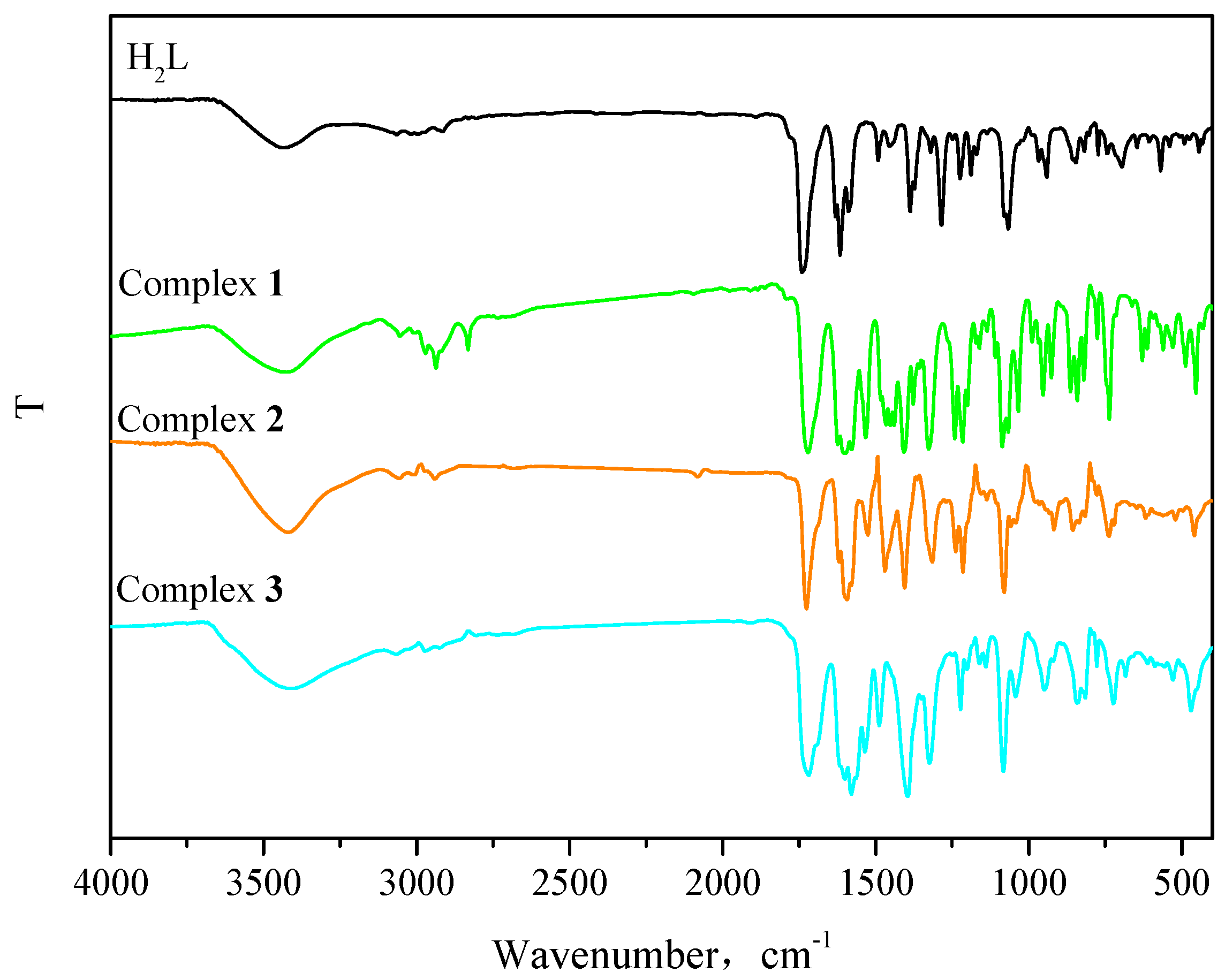
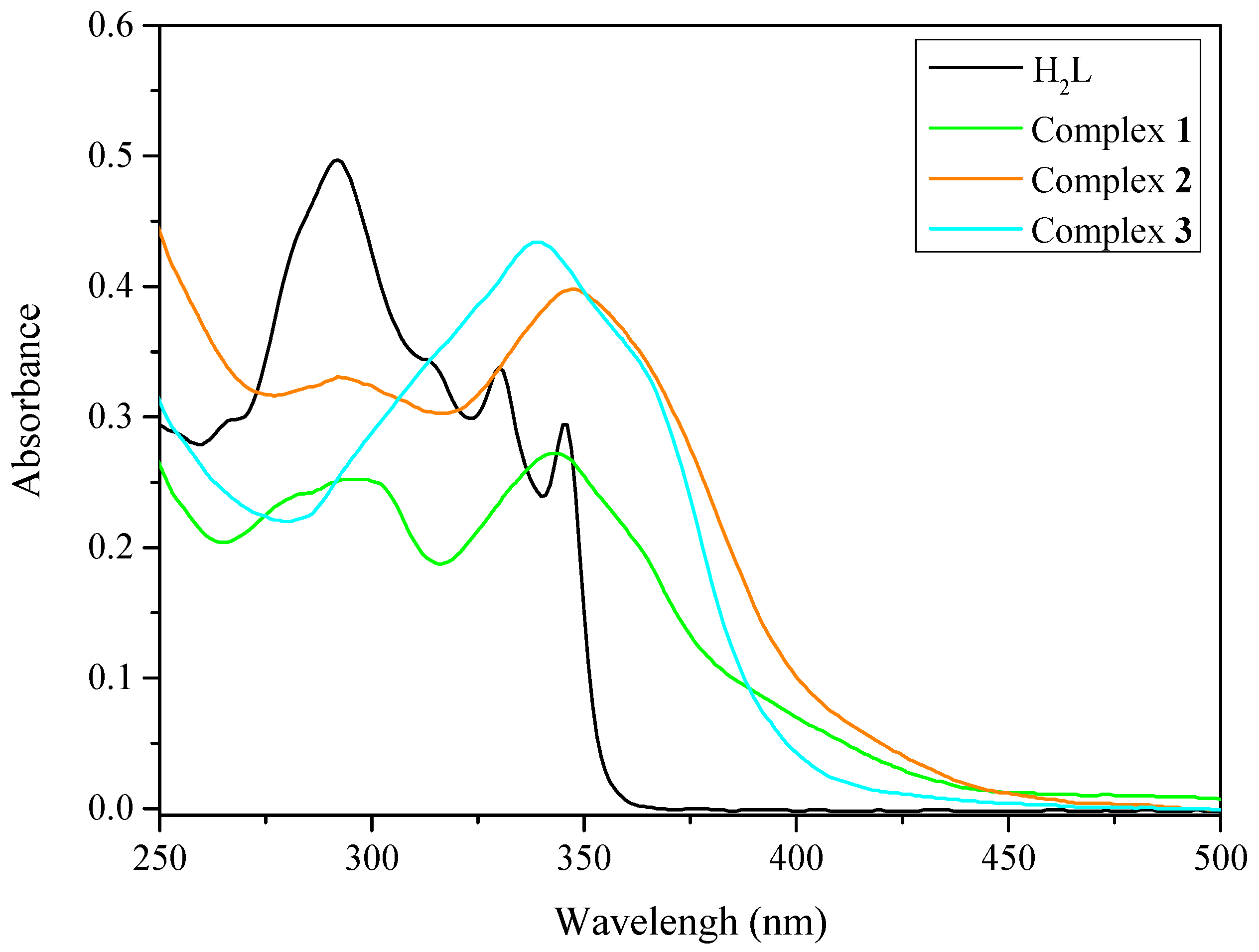
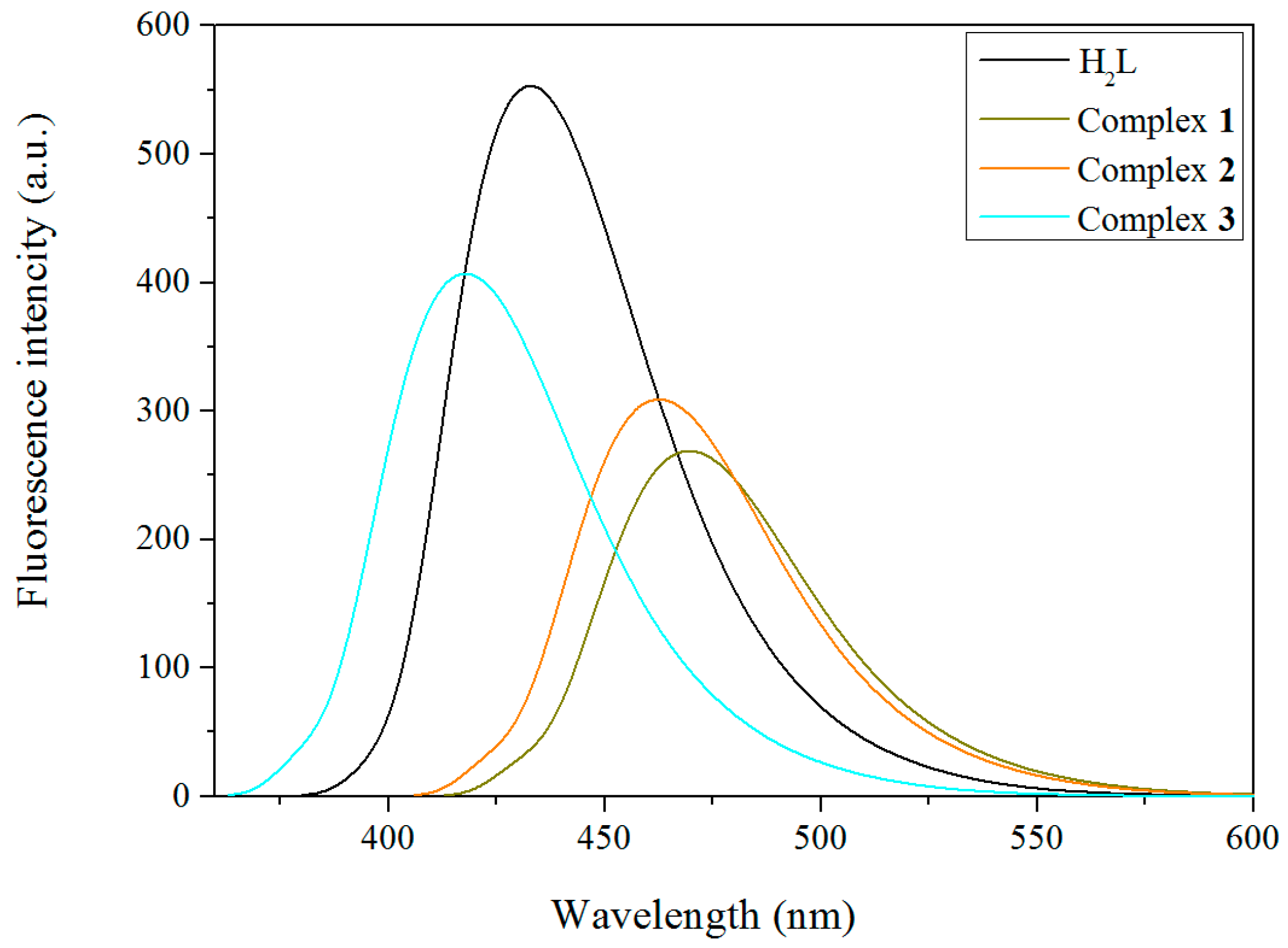


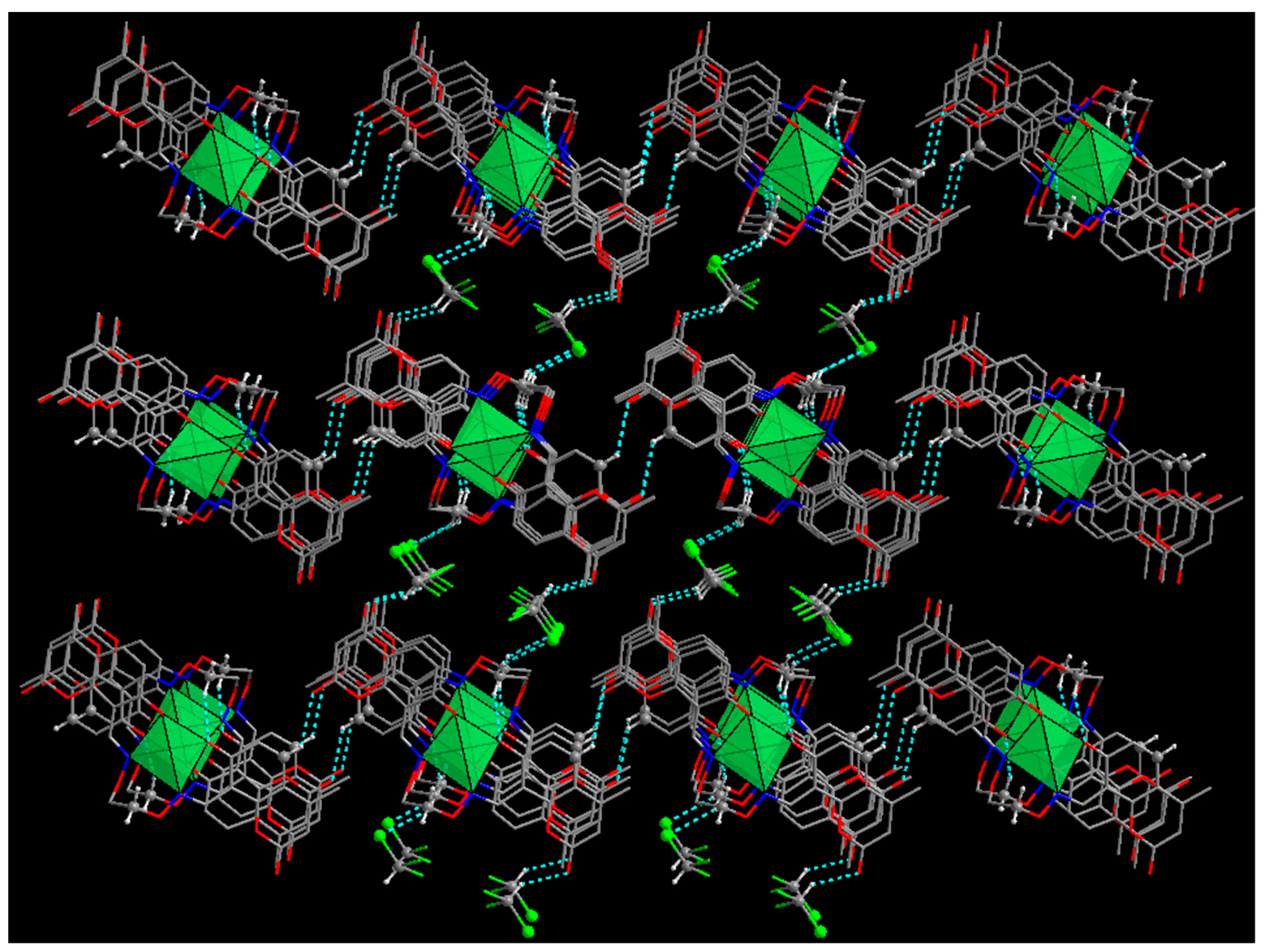
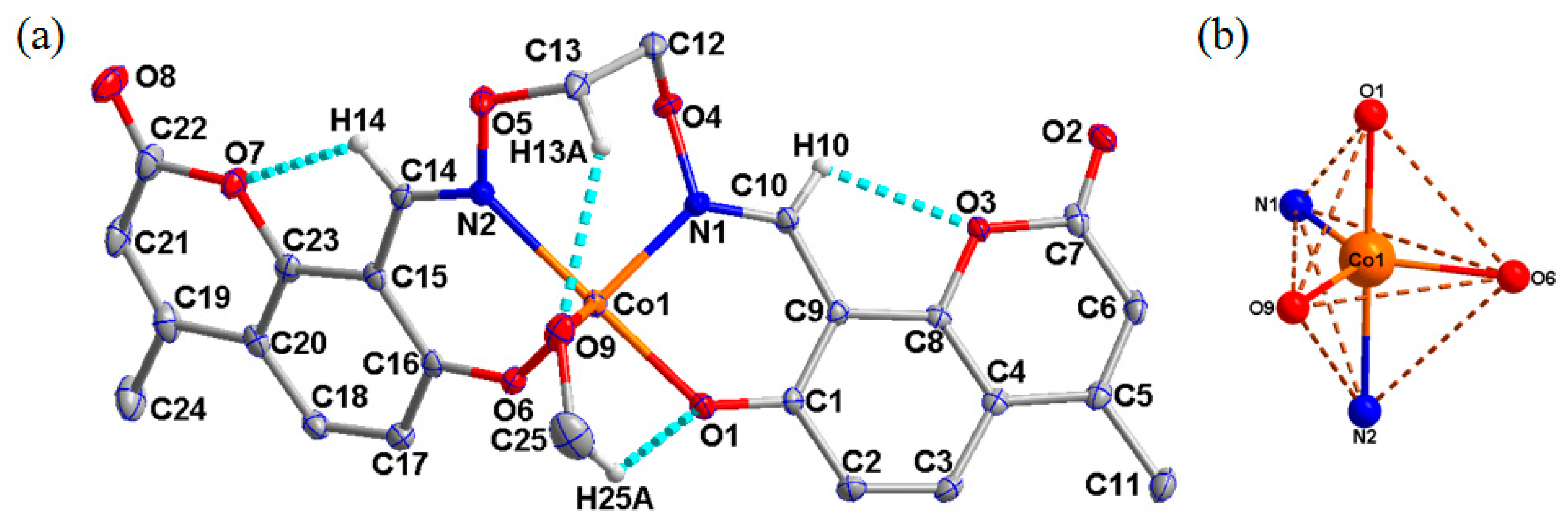
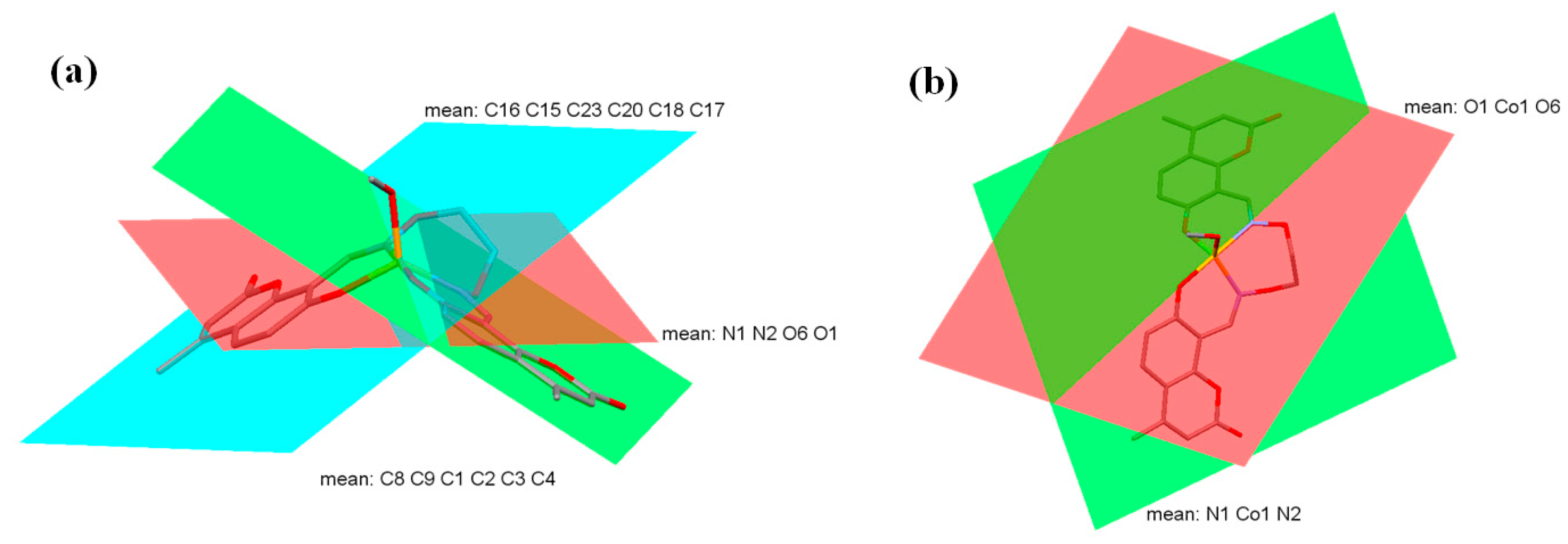
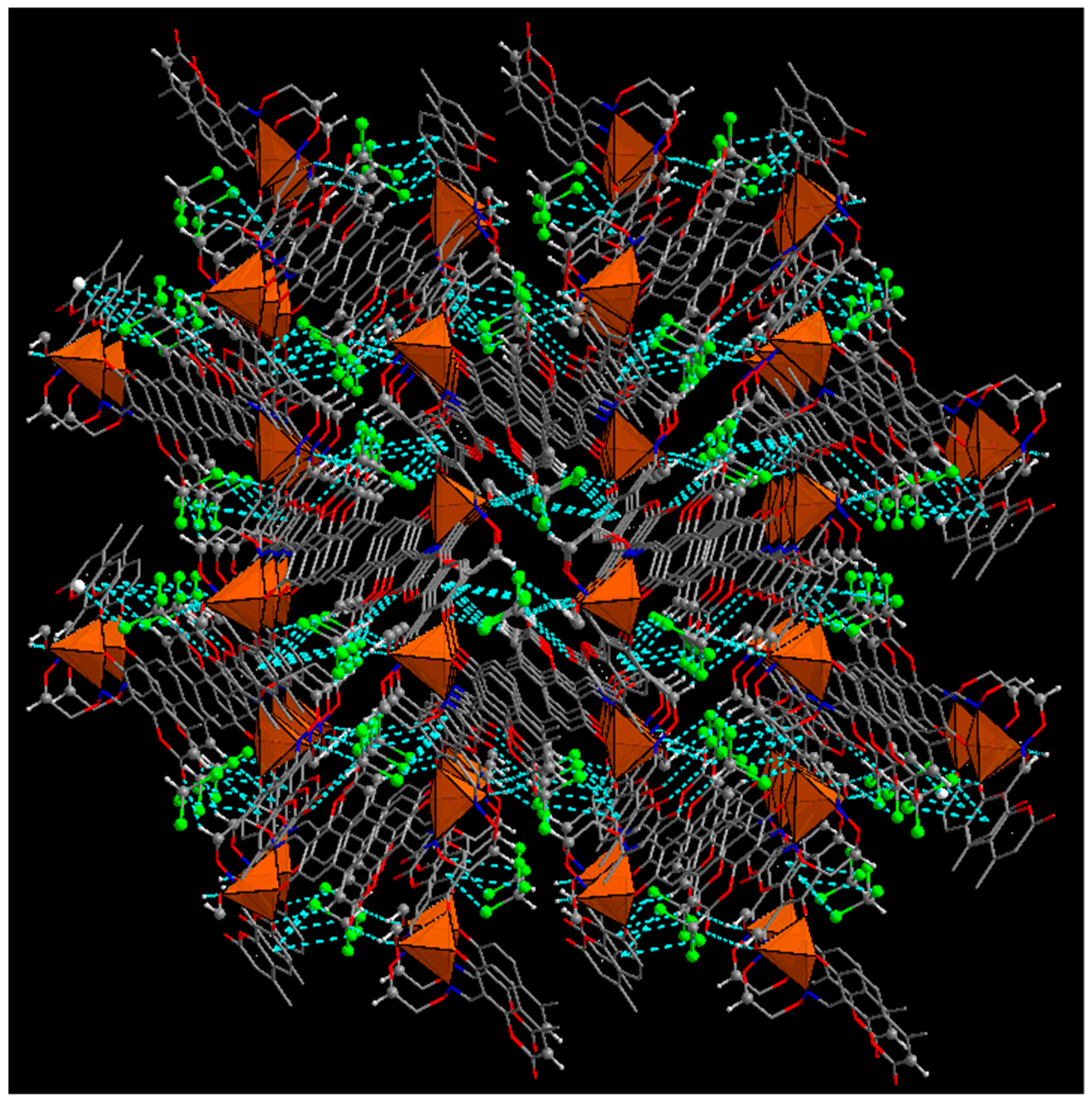
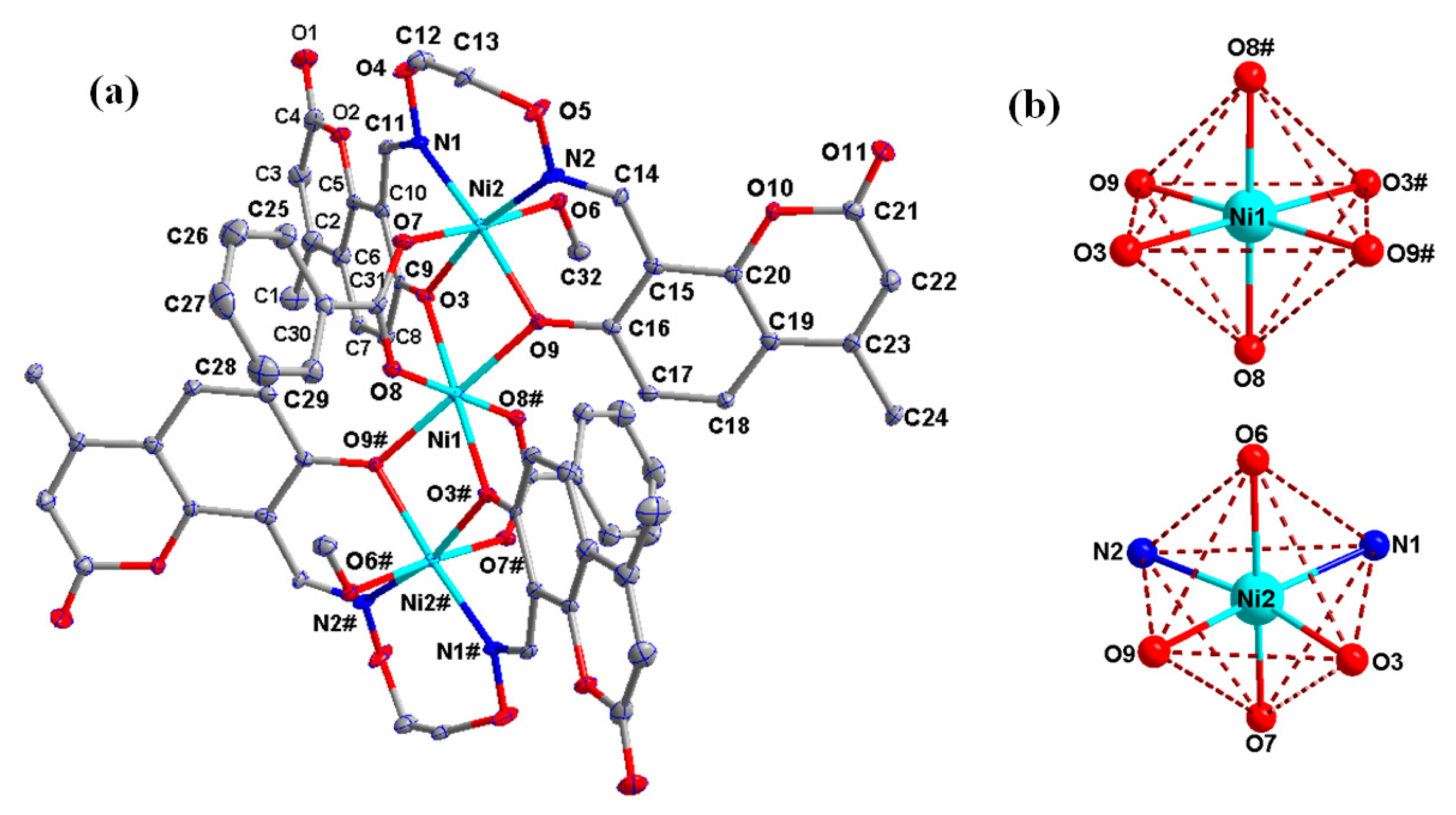
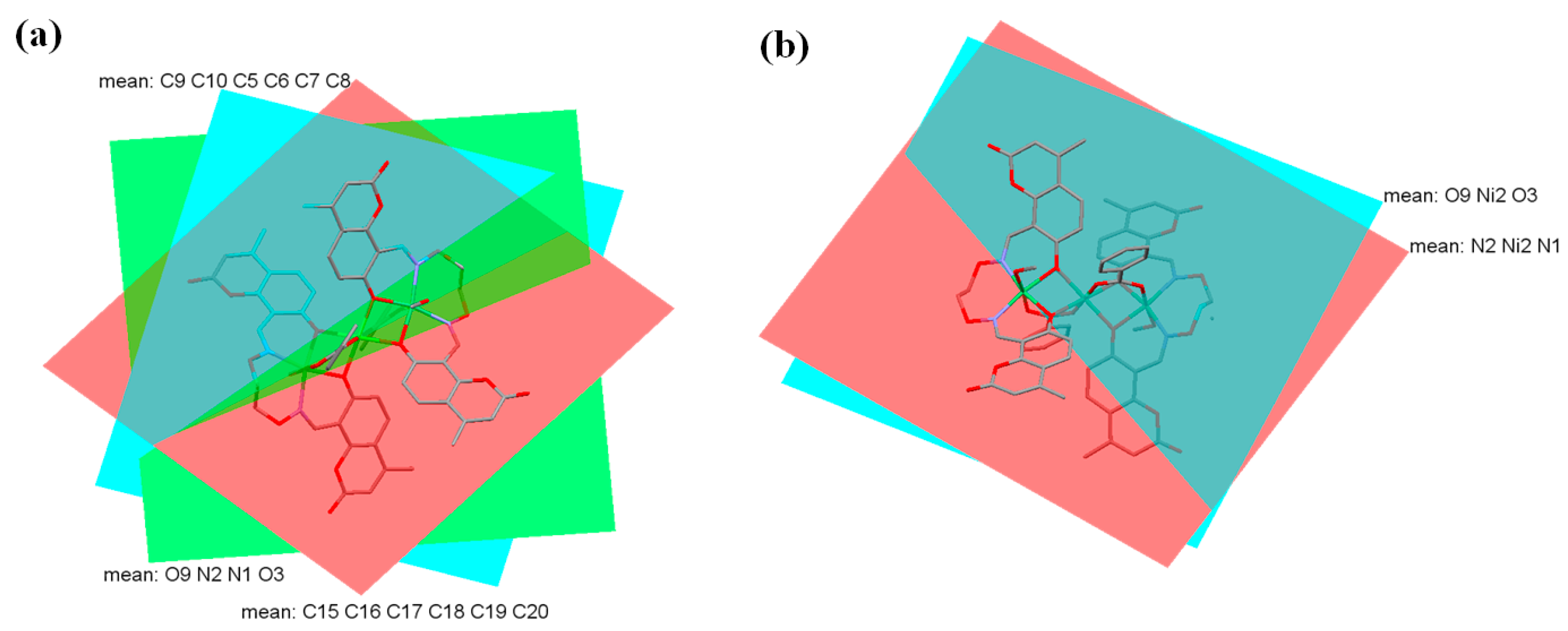
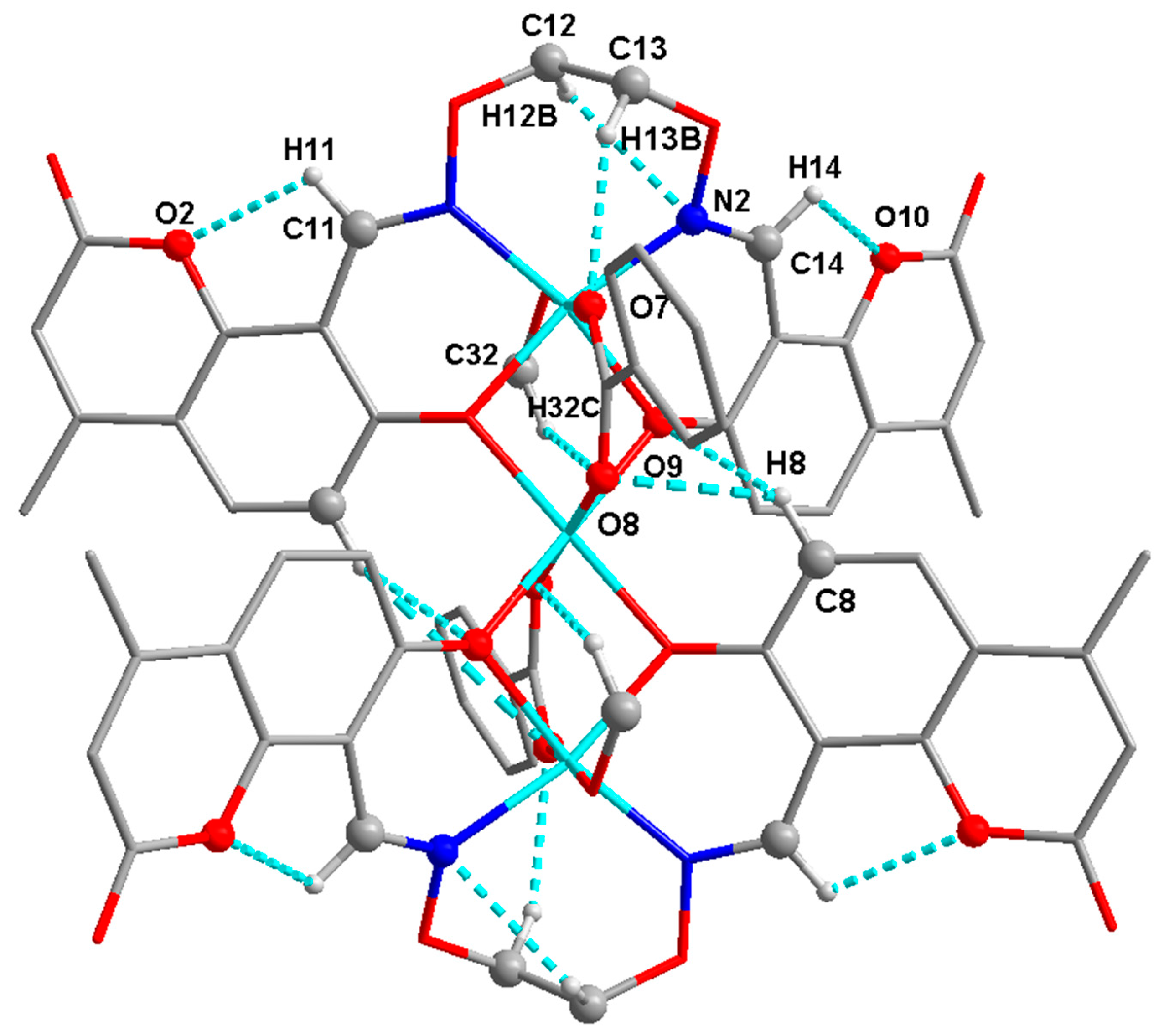
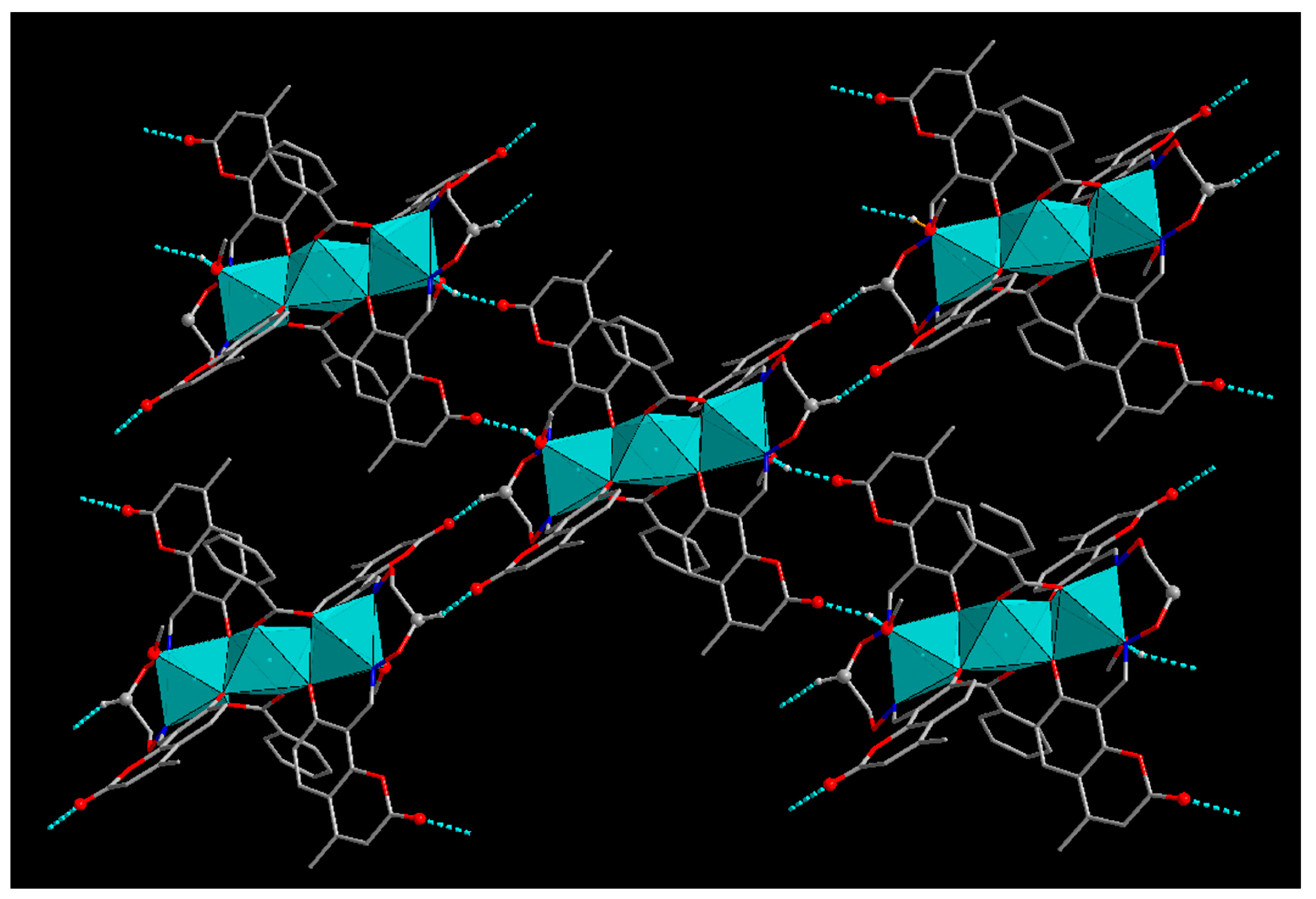
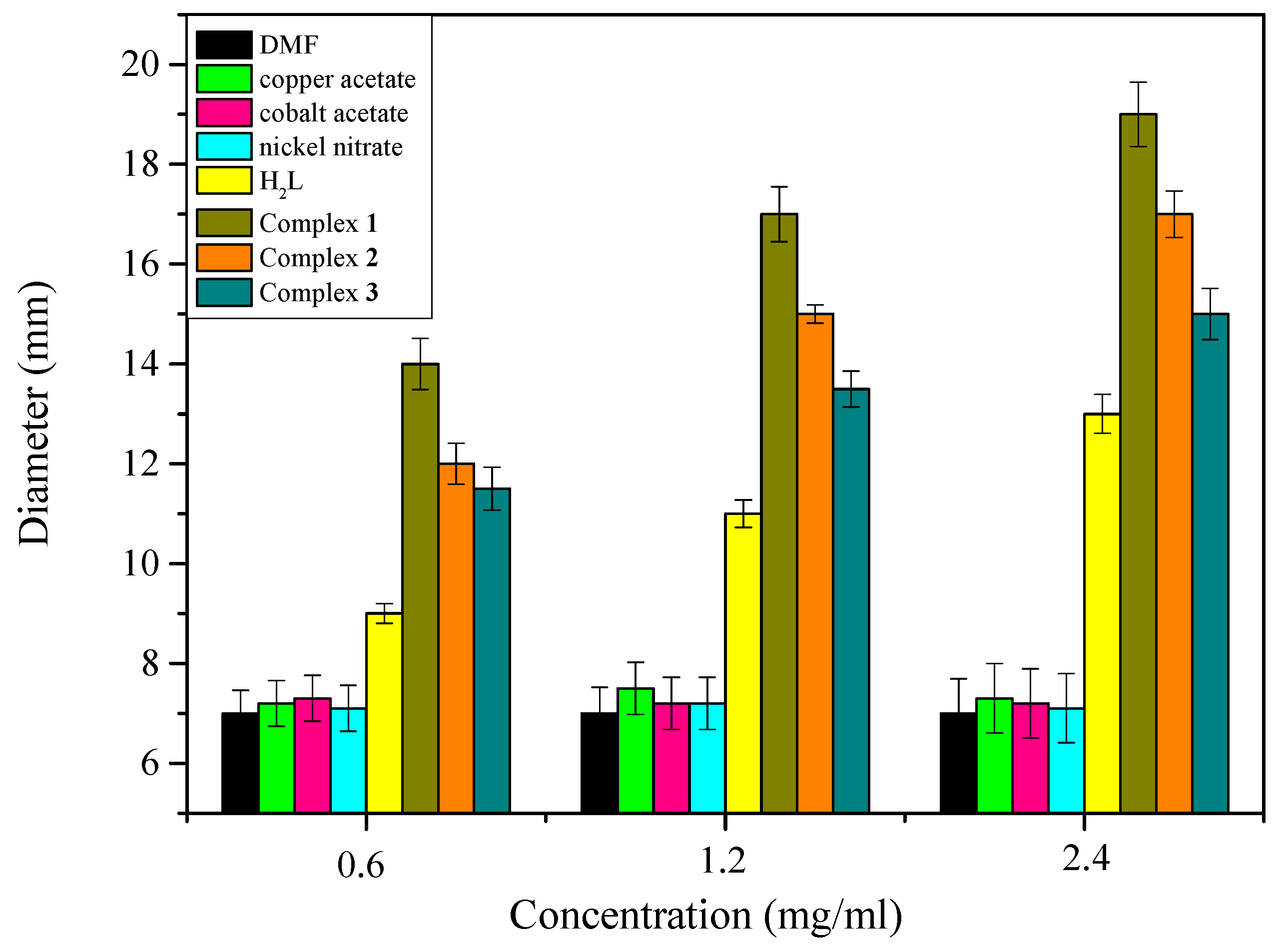
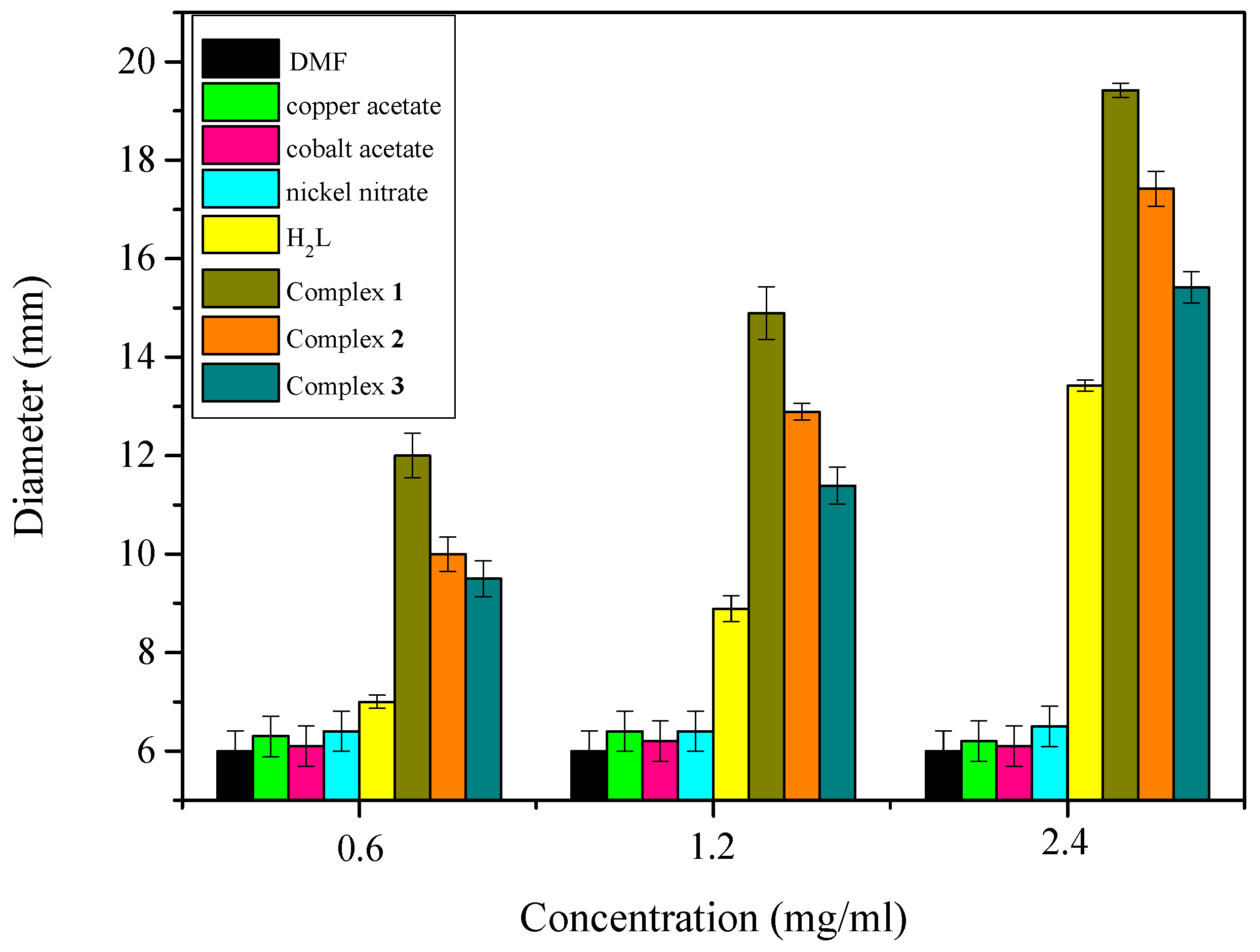
| Complex | 1 | 2 | 3 |
|---|---|---|---|
| Formula | C25H19Cl3CuN2O8 | C26H23Cl3CoN2O9 | C64H54N4Ni3O22 |
| Formula weight | 645.31 | 672.74 | 1407.24 |
| Temperature (K) | 296(2) | 173.00(10) | 153(2) |
| Wavelength (Å) | 0.71073 | 0.71073 | 0.71073 |
| Crystal system | Monoclinic | Monoclinic | Triclinic |
| Space group | P21/c | P21/c | P–1 |
| Unit cell dimensions | |||
| a (Å) | 13.5401(9) | 12.1129(5) | 12.6250(18) |
| b (Å) | 6.8318(5) | 13.5779(3) | 12.6344(17) |
| c (Å) | 27.1822(16) | 16.7455(6) | 14.7046(18) |
| α (°) | 90 | 90 | 113.420(4) |
| β (°) | 94.8504(19) | 100.038(3) | 95.978(5) |
| γ (°) | 90 | 90 | 107.557(2) |
| V (Å3) | 2505.4(3) | 2711.93(15) | 1983.6(5) |
| Z | 4 | 4 | 1 |
| Dc (g cm−3) | 1.711 | 1.648 | 1.178 |
| μ (mm−1) | 1.247 | 0.987 | 0.770 |
| F (000) | 1308 | 1372 | 726 |
| Crystal size (mm) | 0.26 × 0.22 × 0.19 | 0.16 × 0.07 × 0.04 | 0.22 × 0.19 × 0.18 |
| θ Range (°) | 2.219–25.005 | 3.416–26.020 | 1.750–25.010 |
| −16 ≤ h ≤ 16, | −9 ≤ h ≤ 14, | −13 ≤ h ≤ 15 | |
| Index ranges | −8 ≤ k ≤ 6 | −16 ≤ k ≤ 15 | −15 ≤ k ≤ 15 |
| −32 ≤ l ≤ 31 | −20 ≤ l ≤ 20 | −17 ≤ l ≤ 16 | |
| Reflections collected | 16385 | 10655 | 14781 |
| Independent reflections | 4402 | 5343 | 6919 |
| Rint | 0.0746 | 0.0410 | 0.0661 |
| Completeness | 99.9% | 99.7% | 99.0% |
| Data/restraints/parameters | 4402/0/354 | 5343/4/376 | 6919/69/319 |
| GOF | 1.097 | 1.053 | 1.050 |
| Final R1, wR2 indices | 0.0659, 0.1066 | 0.0585, 0.1315 | 0.0579, 0.1580 |
| R1, wR2 indices (all data) | 0.1058, 0.1207 | 0.0861, 0.1530 | 0.0890, 0.1779 |
| Largest differences | 0.364/−0.439 | 1.211/−0.653 | 0.935/−0.828 |
| peak and hole (e Å−3) | |||
| Compound | ν(C=N) | ν(Ar-O) | ν(C=O) | ν(C=C) |
|---|---|---|---|---|
| H2L | 1616 | 1282 | 1734 | 1386 |
| Complex 1 | 1601 | 1242 | 1722 | 1320 |
| Complex 2 | 1597 | 1238 | 1726 | 1312 |
| Complex 3 | 1605 | 1222 | 1719 | 1325 |
| Compound | λmax1, nm | εmax1, M−1·cm−1 | λmax2, nm | εmax2, M−1·cm−1 | λmax3, nm | εmax3, M−1·cm−1 |
|---|---|---|---|---|---|---|
| H2L | 291 | 4.9 × 10−4 | 330 | 3.3 × 10−4 | 345 | 2.9 × 10−4 |
| Complex 1 | 299 | 2.5 × 10−4 | 343 | 2.7 × 10–4 | 396 | 0.7 × 10−4 |
| Complex 2 | 297 | 3.2 × 10−4 | 347 | 3.9 × 10−4 | 399 | 0.9 × 10−4 |
| Complex 3 | 338 | 4.3 × 10−4 | 391 | 0.7 × 10−4 |
| Bond | |||
| Cu1-O1 | 1.891(3) | Cu1-N1 | 1.950(4) |
| Cu1-O2 | 1.909(3) | Cu1-N2 | 1.976(4) |
| Angles | |||
| O1-Cu1-O2 | 83.86(14) | O1-Cu1-N2 | 90.30(15) |
| O1-Cu1-N1 | 162.19(18) | O2-Cu1-N2 | 161.44(17) |
| O2-Cu1-N1 | 89.28(15) | N1-Cu1-N2 | 100.99(16) |
| D-H · A | D · A | D-H · A |
|---|---|---|
| C10-H10 · O4 | 2.724(6) | 103 |
| C13-H13 · O7 | 2.715(5) | 103 |
| C12-H12B · O1 | 3.495(6) | 156 |
| C20-H20 · O3 | 3.284(6) | 133 |
| C25-H25 · O8 | 3.071(7) | 141 |
| C12-H12A · Cl1 | 3.561(6) | 136 |
| Bond | |||
| Co1-O1 | 2.008(3) | Co1-N1 | 2.014(3) |
| Co1-O6 | 1.926(3) | Co1-N2 | 2.150(3) |
| Co1-O9 | 2.039(3) | ||
| Angles | |||
| O1-Co1-O9 | 90.67(12) | O6-Co1-N1 | 124.97(14) |
| O1-Co1-N1 | 88.52(12) | O6-Co1-N2 | 86.65(12) |
| O1-Co1-N2 | 178.25(13) | O9-Co1-N2 | 91.00(13) |
| O6-Co1-O1 | 93.23(11) | N1-Co1-O9 | 124.07(14) |
| O6-Co1-O9 | 110.91(13) | N1-Co1-N2 | 90.12(12) |
| D-H···A | D···A | D-H···A | ||
| C10-H10···O3 | 2.682(4) | 104 | ||
| C13-H13A···O9 | 3.433(6) | 145 | ||
| C14-H14···O7 | 2.712(5) | 103 | ||
| C25-H25A···O1 | 3.041(7) | 125 | ||
| O9-H9···O2 | 2.651(4) | 166 | ||
| C6-H6···O6 | 3.315(4) | 139 | ||
| C13-H13B···O2 | 3.309(5) | 134 | ||
| C26-H26···O8 | 3.146(6) | 156 | ||
| C25-H25C···Cl3 | 3.642(6) | 159 | ||
| D-X···A | D-X | X···A | D···A | D-X···A |
| C26-Cl1···Cg6 | 1.757(5) | 3.824 | 4.415(5) | 97.59 |
| C26-Cl2···Cg6 | 1.757(5) | 3.849 | 4.415(5) | 96.78 |
| C26-Cl2···Cg4 | 1.757(5) | 3.655 | 4.557(5) | 109.67 |
| Bond | |||
| Ni1-O3 | 2.082(3) | Ni2-O3 | 2.014(3) |
| Ni1-O3# | 2.082(3) | Ni2-O6 | 2.150(3) |
| Ni1-O8 | 2.031(3) | Ni2-O7 | 2.018(3) |
| Ni1-O8# | 2.031(3) | Ni2-O9 | 2.040(3) |
| Ni1-O9# | 2.089(3) | Ni2-N1 | 2.068(4) |
| Ni1-O9 | 2.089(3) | Ni2-N2 | 2.069(4) |
| Angles | |||
| O3-Ni1-O3# | 180.0 | O3-Ni2-O6 | 93.13(12) |
| O3#-Ni1-O9 | 101.51(11) | O3-Ni2-O9 | 80.97(11) |
| O3-Ni1-O9# | 101.51(11) | O3-Ni2-N1 | 87.44(13) |
| O3-Ni1-O9 | 78.49(11) | O7-Ni2-O3 | 90.35(13) |
| O3#-Ni1-O9# | 78.49(11) | O7-Ni2-O6 | 175.38(11) |
| O8#-Ni1-O3# | 90.07(12) | O7-Ni2-O9 | 94.69(12) |
| O8#-Ni1-O3 | 89.93(12) | O7-Ni2-N1 | 91.74(15) |
| O8-Ni1-O3# | 89.93(12) | O7-Ni2-N2 | 90.06(15) |
| O8-Ni1-O3 | 90.07(12) | O9-Ni2-O6 | 88.86(12) |
| O8#-Ni1-O8 | 180.0 | O9-Ni2-N1 | 166.76(13) |
| O8#-Ni1-O9# | 88.56(12) | O9-Ni2-N2 | 85.38(13) |
| O8-Ni1-O9 | 88.56(12) | N1-Ni2-O6 | 85.38(14) |
| O8#-Ni1-O9 | 91.44(12) | N1-Ni2-N2 | 106.20(14) |
| O8-Ni1-O9# | 91.44(12) | N2-Ni2-O6 | 87.29(15) |
| O9#-Ni1-O9 | 180.0 |
| D-H···A | D···A | D-H···A |
|---|---|---|
| C8-H8···O8 | 3.176(6) | 122 |
| C8-H8···O9 | 3.289(5) | 133 |
| C11-H11···O2 | 2.661(6) | 103 |
| C12-H12B···N2 | 2.878(9) | 102 |
| C13-H13B···O7 | 3.110(8) | 142 |
| C14-H14···O10 | 2.673(6) | 101 |
| C32-H32C···O8 | 3.362(6) | 155 |
| O6-H6···O1 | 2.741(5) | 164 |
| C12-H12A···O11 | 3.180(8) | 154 |
© 2018 by the authors. Licensee MDPI, Basel, Switzerland. This article is an open access article distributed under the terms and conditions of the Creative Commons Attribution (CC BY) license (http://creativecommons.org/licenses/by/4.0/).
Share and Cite
Gao, L.; Liu, C.; Wang, F.; Dong, W.-K. Tetra-, Penta- and Hexa-Coordinated Transition Metal Complexes Constructed from Coumarin-Containing N2O2 Ligand. Crystals 2018, 8, 77. https://doi.org/10.3390/cryst8020077
Gao L, Liu C, Wang F, Dong W-K. Tetra-, Penta- and Hexa-Coordinated Transition Metal Complexes Constructed from Coumarin-Containing N2O2 Ligand. Crystals. 2018; 8(2):77. https://doi.org/10.3390/cryst8020077
Chicago/Turabian StyleGao, Lei, Chang Liu, Fei Wang, and Wen-Kui Dong. 2018. "Tetra-, Penta- and Hexa-Coordinated Transition Metal Complexes Constructed from Coumarin-Containing N2O2 Ligand" Crystals 8, no. 2: 77. https://doi.org/10.3390/cryst8020077
APA StyleGao, L., Liu, C., Wang, F., & Dong, W.-K. (2018). Tetra-, Penta- and Hexa-Coordinated Transition Metal Complexes Constructed from Coumarin-Containing N2O2 Ligand. Crystals, 8(2), 77. https://doi.org/10.3390/cryst8020077




